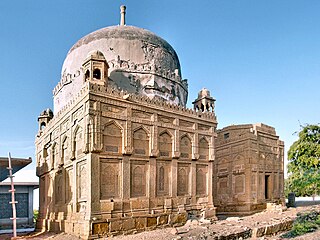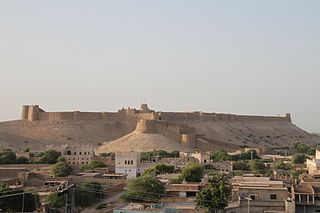
Mirpur Khas is the capital city of the Mirpur Khas District and Mirpur Khas Division in the Sindh province, Pakistan. Mirpur Khas is the 16th largest city in Sindh province and the 80th largest city of Pakistan. The city was built by Talpur rulers of Mankani branch. According to the 2017 Census of Pakistan, its population is 233,916. Mirpur Khas is known for its mango cultivation, with hundreds of varieties of the fruit produced each year - it is also called the “City of Mangoes,” and has been home to an annual mango festival since 1955. After the completion of Hyderabad-Mirpurkhas dual carriage way, the city has become hub of commercial activities.

Khairpur(Sindhi and Urdu: خيرپور) is a city and the capital of the Khairpur District of Sindh.

Khairpur District is a district in the Pakistani province of Sindh in Sukkur Division. At the 2017 census, it was the fifth most populated district in the province after four districts of Karachi city, with 2.4 million inhabitants. The headquarters of the district is the city of Khairpur. The district is further divided into eight sub-districts: Khairpur Tehsil, Mirwah Tehsil, Kot Diji Tehsil, Kingri Tehsil, Sobho Dero Tehsil, Gambat Tehsil, Faiz Ganj Tehsil and Nara Tehsil.

Jamshoro is a city and the capital of Jamshoro District, located in Sindh, Pakistan. It is on the right bank of the Indus River, approximately 18 km (11 mi) northwest of Hyderabad and 150 km (93 mi) northeast from the provincial capital of Sindh, Karachi.

The Battle of Miani was a battle between forces of the Bombay Army of the East India Company, under the command of Charles Napier and the Baluch army of Talpur Amirs of Sindh, led by Mir Nasir Khan Talpur. The battle took place on 17 February 1843 at Miani, Sindh, in what is now modern-day Pakistan. This battle and the subsequent Battle of Hyderabad eventually led to the capture of parts of Sindh region, first territorial possession by the East India Company in what is the modern-day state of Pakistan.
Talpur is a Saraiki-speaking Baloch sub-clan of the Hoth tribe settled in Sindh, Punjab and Balochistan in Pakistan. The tribe established the Talpur dynasty, which ruled between 1783 and 1843, while a branch of the dynasty ruled until 1955 as the Khairpur princely state.

Ranikot Fort is a historical Talpur fort near Sann, Jamshoro District, Sindh. in Pakistan. Ranikot Fort is also known as The Great Wall of Sindh and is believed to be the world's largest fort, with a circumference of approximately 32 kilometres (20 mi). The fort's ramparts have been compared to the Great Wall of China.

The State of Khairpur, also transliterated as Khayrpur, was a princely state of British India on the Indus River in northern Sindh, modern Pakistan, with its capital city at Khairpur. It was established as capital for the Sohrabani branch of the Talpur dynasty, and was established shortly after Talpur ascendency in 1783 as one of several Talpur dominions. Whereas the other Talpur dominions were conquered by the British in 1843, the Khairpur state entered into treaty with the British, thereby maintaining some of its autonomy as a princely state. The last Mir of Khairpur opted to join the new state of Pakistan in 1947, and the dominion was thus made a Princely state of Pakistan, until it was fully amalgamated into West Pakistan in 1955.

The Kot Diji Fort, formally known as Fort Ahmadabad, is an 18th-century Talpur-era fort located in the town of Kot Diji in Khairpur District, Pakistan, about 25 miles east of the Indus River at the edge of the Thar Desert. The fort sits above a pre-Harappan Civilization archaeological site dating to 2500 to 2800 B.C.E.

The Talpur dynasty were rulers based in Sindh. Four branches of the dynasty were established following the defeat of the Kalhora dynasty at the Battle of Halani in 1783: one ruled lower Sindh from the city of Hyderabad, another ruled over upper Sindh from the city of Khairpur, a third ruled around the eastern city of Mirpur Khas, and a fourth was based in Tando Muhammad Khan. The Talpurs were ethnically Baloch. For most of their rule, they were subordinate to the Durrani Empire and were forced to pay tribute to them.

Syed Qaim Daim Ali Shah is a Pakistani politician who served as the elected Chief Minister of Sindh for three terms. His last two terms combined, a total of eight years, makes him the longest serving Chief Minister of Sindh. He is Sindh President of the Pakistan Peoples Party (PPP) and an elected Member of Provincial Assembly (MPA) from PS-220 (Khairpur-1).
Mir Shahdad Jo Qubo,, is located in Shahpur Chakar (city) of the Sanghar District, in Sindh Province of southern Pakistan.
Faryal Talpur is a Pakistani politician who had been a member of the National Assembly of Pakistan from 2008 to May 2018 and currently serving as a Member of the Provincial Assembly of Sindh as well as the President of the Women Wing of the Pakistan People's Party.
Sohrab Fakir Manganhar, also known as Sohrab Fakir, was a Sufi-singer from Sindh, Pakistan.
The Baloch of Sindh, also known as the Sindhi Balochs, is a community of Sindhi-speaking Baloch tribes living in the Northern part of Sindh province.

Sindh is a province in Pakistan.
The Battle of Halani was fought in 1783 between the Baloch tribe of Talpurs and the Sindhi tribe of Kalhora near Halani village for the control of the Sindh region, in modern-day Pakistan. The Talpurs, led by Mir Fateh Ali Khan Talpur, won the battle over Mian Abdul Nabi Kalhoro of the Kalhora dynasty, and established the Talpur dynasty.

The Faiz Mahal is a palace in Khairpur, Sindh, Pakistan.
Jani Buriro is a village of Taluka Kot Diji, Khairpur District, Sindh. Village situates at 12 km on Main Highway from Khairpur to Karachi, Pakistan.

George Ali Murad Khan II Talpur is a member of the Talpur dynasty who was the Mir (ruler) of Khairpur from 1947 to 1954. At an age of nine months, Khan was mistakenly shot by his father. Although the bullet passed through his right lung and stomach, he survived. Ascending to the throne after his father's removal from power, he chose to accede to the Dominion of Pakistan in the same year and was invested with full powers by Liaquat Ali Khan in 1951. Three years later, the state merged with Pakistan, removing Khan's sovereign status. Khan fathered two sons, Abbas Raza Khan and Mehdi Raza Khan and one daughter Zahra from his second wife.













